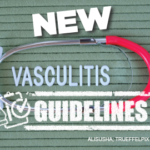We recommend non-glucocorticoid and non-biologic medications and TNF inhibitors over tocilizumab. However, if patients do not respond to, or have a contraindication against, TNF inhibitors, tocilizumab could be a valid alternative. And remember: This particular question yielded a conditional recommendation, meaning there may be situations in which tocilizumab may be the preferred agent.
Q: What considerations led to the recommendation to continue therapy, instead of switching therapy, for patients who have asymptomatic progression? Would you be at all worried about someone being undertreated for asymptomatic progression?
Dr. Abril: That’s a concern, of course. Asymptomatic progression could occur in a few different scenarios. Some patients may have some slowly progressive disease. Others may have stable symptoms due to the combination of stenotic vessels and new collateral vessels. However, it’s the rate of progression that’s important.
For example, let’s say you image a patient’s vessels, and then six months later, you image them again, and it’s a little bit worse, but the patient is symptomatically normal. I would feel comfortable continuing the current treatment plan. But if the vessels demonstrated significant worsening after three months, you might be more inclined to change therapy.
One also needs to consider which vessel is involved. If it’s a critical vessel—a coronary or carotid artery, for example—then you’d be a lot more concerned. The important thing is that when you identify those patients you may not necessarily increase or escalate therapy, but you would definitely need to follow closely. That’s the key here: to follow up.
Q: What were the thoughts of the guideline group, or even in your own practice, regarding what types of imaging to do and how frequently to perform them? The guidelines made a conditional recommendation for immunosuppressive therapy for new lesions without specifying how often or what type of imaging.
Dr. Abril: This was one of the questions that generated a fair amount of discussion. Some of us wanted to give a recommendation based on current clinical practice, while others wanted to be true to the methodology we used to make the other recommendations. There are no solid data regarding which studies should be performed at what intervals, which is the main reason a concrete recommendation was not given.
If you see a patient with early disease, you definitely should image earlier. In my own practice, I may want to image such a patient at three months. In the guideline, I think we say that patients should be imaged at three to six months. Then you want to re-image soon to see if the patient is responding to therapy and to make sure the patient doesn’t have rapidly progressive or critical stenosis.


